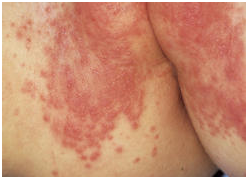Jacquest Erythema Causes, Symptoms, Diagnosis and Treatment

What is Jacquest Erythema?
Jacquest Erythema, also known as irritant contact diaper dermatitis (IDD), is the result of the combined influence of heat, urine, moisture, friction, feces and secondary infection. Jacquet dermatitis is a rare, distinctive, heavy variant of IDD. It is characterized by stamped erosions or ulcerations with crater-like edges and is typically associated with frequent fluid chairs, poor hygiene, rare diaper changes, or closable plastic diapers. It is more common in children with chronic diarrhea or incontinence, such as those with spina bifida or deer disease.
Causes of Jacquest Erythma
- Jacquest Erythema is caused by a combination of localized physical, chemical and mechanical irritation (such as urine, stool, friction and moisture).
- The rash is usually about the areas in contact with the wet diaper buttocks, abdomen, medial thighs, labia, mons pubis and scrotum. Due to the lack of contact, the fold areas are usually spared.
- The skin rash is erythematous, papular, and has scaling areas. The skin appears edematous and inflamed causing the child to become irritated. With the chronicity, the skin becomes dry. Chronic irritation can lead to ulceration
- Because of the increased moisture, there is a change in the permeability of the epidermis, which allows increased ingress of irritants and increased susceptibility to friction damage by diaper. This is caused by stool enzyme activation (urease), interaction with urine increases the pH to further irritate and damage the skin.
Symptoms of Jacquest Erythma
Diaper skin usually comes quickly, and it affects the areas of the baby’s body, which is in close contact with the diaper. While there are some common symptoms of Jacquest Erythma, there is wide variation in what diaper runout looks like.
- Pinkness or redness over small or large area, wherever the diaper touches
- Flaking, dryness or peeling/scaling of the skin
- Crafting from friction of the diaper rubbing against baby skin
- Skin is more sensitive and warmth to touch
- Dry raised bumps papules/ fluid raised bumps pustules
- Edema /swelling
- Baby cries in pain when the diaper rash is touched
- Baby has a fever
- The diaper rash blisters or begins bleeding
- The rash spreads to other parts of the body, such as the arms or face
- The rash does not improve in 7 days, or subsides and then reoccurs
Diagnosis of Jacquest Erythema
The diagnosis of Jacquest Erythema is largely based on physical examination. A careful history, however, could indicate a reduction in differential diagnosis.
Important points to get on history include the following:
- Start, duration and change in the nature of the skin rash
- Presence of skin rash outside the diaper area
- Related scratching or crying
- Contact with infants with a similar rash
- Actual disorders, diarrhea or antibiotic use
Treatment of Jacquest Erythema
- Maintaining dry , protected skin is vital
- Allowing diaper free intervals
- Decrease scrubbing of the area when changing
- Barrier creams or thick pastes containing zinc oxide, titanium dioxide and starch or creams with dexpanthenol
- Avoid humidity and minimize transepidermal water loss.
- Bathing should be performed daily
- Cornstarch and other powders will area dry and decrease friction
- Anti-inflammatory topical steroid are useful if above measure fail
- Antibiotics may be necessary for secondary bacterial infection
Related Articles:
Candidiasis Causes, Symptoms, Diagnosis and Treatment
Herpes Zoster Causes, Symptoms, Diagnosis and Treatment
Yaws Causes, Symptoms, Diagnosis and Treatment
Molluscum Contagiosum Causes, Symptoms, Diagnosis and Treatment
Seborrheic Dermatitis Causes, Symptoms, Diagnosis and Treatment
Monkey Pox Causes, Symptoms, Diagnosis and Treatment
Myiasis Causes, Symptoms, Diagnosis and Treatment
Osteomyelitis Causes, Symptoms, Diagnosis and Treatment
Radiation Sickness Causes, Symptoms, Diagnosis and Treatment
Typhus Causes, Symptoms, Diagnosis and Treatment
By : Natural Health News




